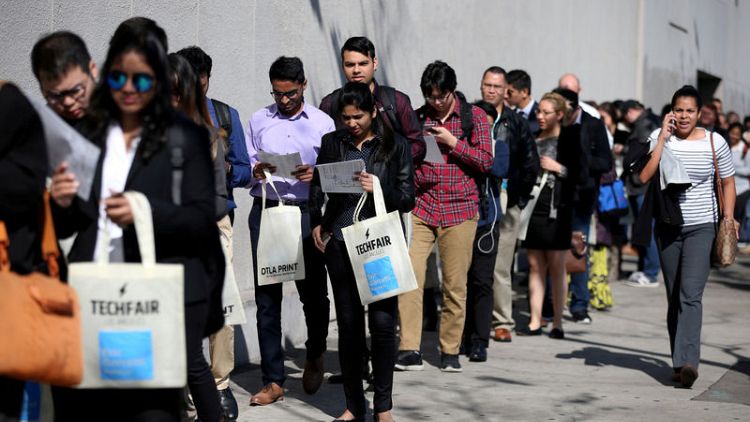By Lucia Mutikani
WASHINGTON (Reuters) - The number of Americans filing applications for unemployment benefits fell more than expected last week, pointing to underlying labour market strength despite a sharp slowdown in job growth in May.
But the outlook for the economy continues to darken. Other data on Thursday showed factory activity in the mid-Atlantic region stalled in June, likely reflecting a recent escalation in trade tensions between the United States and China.
The trade war has increased uncertainty over the U.S. economic outlook, prompting the Federal Reserve on Wednesday to signal it could cut interest rates by as much as half a percentage point over the rest of this year. The U.S. central bank kept rates unchanged on Wednesday.
"Solid labour market conditions supporting a strong consumer sector provides a solid base underneath the economy," said Jim Baird, chief investment officer at Plante Moran Financial Advisors in Kalamazoo, Michigan.
Initial claims for state unemployment benefits dropped 6,000 to a seasonally adjusted 216,000 for the week ended June 15, the Labor Department said. Economists polled by Reuters had forecast claims would decrease to 220,000 in the latest week.
The Labor Department said no states were estimated. The drop in claims followed three straight weekly increases. Claims are being closely watched for signs of a rise in layoffs stemming from the trade dispute.
The four-week moving average of initial claims, considered a better measure of labour market trends as it irons out week-to-week volatility, rose 1,000 to 218,750 last week.
The claims data covered the survey period for the nonfarm payrolls component of June's employment report. The four-week average of claims was little changed between the May and June survey periods. Still, economists expect payrolls to pick up in June after increasing by 75,000 jobs in May.
Fed Chairman Jerome Powell on Wednesday acknowledged the meagre job gains in May and said "in light of recent developments this bears watching," but also noted that "many labour market indicators remain strong."
The dollar was trading lower against a basket of currencies as investors digested the Fed's signal that it would ease monetary policy. Stocks on Wall Street rallied, with the S&P 500 index hitting a record intraday high. U.S. Treasury prices rose.
SLOWING ECONOMY
Claims have been roughly flat this year, indicating some easing in labour market conditions. Job growth has cooled from the brisk pace in 2018 in line with the economy, which is slowing as the stimulus from last year's massive tax cuts and increased government spending fades.
"The recent flattening out in the data could be viewed as a negative change in momentum," said Daniel Silver, an economist at JPMorgan in New York. "But at least the recent trade developments haven't led to a noticeable increase in filings for unemployment insurance."
The Atlanta Fed is forecasting gross domestic product will rise at a 2.0% annualised rate in the second quarter. The economy grew at a 3.1% pace in the January-March quarter, boosted by a temporary burst in exports and an accumulation of inventories.
The surge in exports, together with a decline in imports, helped to shrink the current account deficit in the first quarter to $130.4 billion (£102.6 billion) from $143.9 billion in the fourth quarter, the Commerce Department said in a separate report on Thursday.
Exports, however, tumbled in April in response to softening global demand. Weak exports and an inventory overhang, especially in the automotive sector, are hobbling manufacturing.
Bottlenecks in the supply chain resulting from the U.S.-China trade war are also squeezing manufacturing, which accounts for about 12% of the economy.
A third report on Thursday from the Philadelphia Fed showed its business conditions index dropped to a reading of 0.3 in June from 16.6 in May. There were decreases in measures of new orders, employment and shipments.
A gauge of prices received by manufacturers in the region tumbled to near a three-year low this month. A measure of prices paid by factories was also the lowest in nearly three years. These findings support expectations that inflation will remain muted this year.
The sharp braking in manufacturing in the region that covers eastern Pennsylvania, southern New Jersey and Delaware was the latest indication that national factory activity continues to slow. A report from the New York Fed earlier this week showed a record plunge in its Empire State manufacturing index to more than a 2-1/2-year low in June.
But there are some rays of hope for manufacturing. The Philadelphia Fed survey's six-month business conditions index rose to a reading of 21.4 this month from 19.7 in May. Its six-month capital expenditures index increased to 28.0 from a reading of 23.3 in the prior month.
"We continue to expect manufacturing reacceleration," said Samuel Coffin, an economist at UBS in Stamford, Connecticut. "Confidence has declined, but we saw signs of an upturn in the last industrial production report."
(Reporting by Lucia Mutikani; Editing by Paul Simao)



